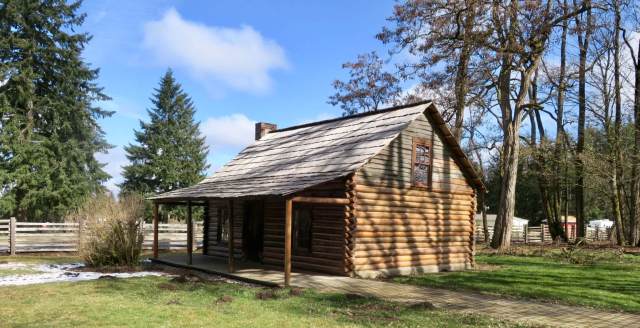With a lazy and surprisingly sunny Saturday stretching in front of us, Mr. Adventure suggested a short jaunt to two more state parks, Jackson House and Matilda Jackson. Situated within a half-mile of each other, they commemorate two of the first Euro-American settlers north of the Columbia River. We stopped at Jackson House first.

Roots of Washington statehood
So much history is crammed into this minuscule (1.4 acres) state park. British-born John R. Jackson emigrated to the United States as a twenty-something and followed the Oregon Trail west from Missouri in 1844. He built a home north of the Columbia River in what was then part of the Oregon Territory. In 1848, he married Matilda Coontz, whose husband had died on the Oregon Trail. The couple and her four sons moved into Jackson’s homestead.
In 1850, Jackson built a larger cabin on the site. It quickly became a social and commercial hub thanks to its location on the Cowlitz Trail, a Native American path connecting the Columbia River and Puget Sound.
As more people migrated west, traffic on the Cowlitz Trail increased. Jackson’s home served as a post office, general store, tavern, hotel, and court. Like his building, Jackson held a variety of roles, including justice of the peace, tax collector, sheriff, assessor, and territorial representative.
In 1852, people who had settled north of the Columbia River met at Jackson’s house and agreed to ask Congress to establish a Washington Territory independent of Oregon. Created on March 2, 1853, the territory initially included all of present-day Idaho and parts of Montana and Wyoming. It became Washington State in 1889.

Both Ulysses S. Grant, who was posted at Fort Vancouver for a time, and Isaac Stevens, first territorial governor of Washington, visited the home.

From history to historic preservation
Whew! But wait, there’s more. This isn’t even the original Jackson House. Five years after John died in 1873, Matilda moved into a newer home on the property (now gone) and the cabin moldered.
In 1914, though, local resident and Jackson descendant Anna Koontz proposed preserving the cabin as a project for the St. Helens Club of Chehalis, a civic group to which she belonged. The club raised $500 to help restore the house. The owner of the property, a man named August Donahoe, donated the cabin and surrounding land to the state to be used as a park. Local workers salvaged materials from the structure and in about three months rebuilt the house to look as it did in 1850, finishing in October 1915.
About seven weeks later, the Washington State Board of Park Commissioners accepted the property as the second state park (after Larrabee, near Bellingham). The Washington State Historical Society completed the stone wall and engraved panels in 1922. Civilian Conservation Corps members stationed at nearby Lewis and Clark State Park did more restoration work on the house in 1934, and the state completed another round of preservation improvements in 2017.

So in addition to the important territorial and state history the house represents, it stands as a monument to early historic preservation efforts. Really, what more could a history geek ask for?

An important stop on an important road
A little more, it turns out. The park has a nice picnic area where you can sit and contemplate Washington’s history. Standing there, I was struck by the juxtaposition of the rebuilt cabin and the road. The Cowlitz Trail extended the Oregon Trail for many settlers who wanted to live north of the Columbia River. With the advent of the automobile, the trail in 1913 became part of the Pacific Highway (later U.S. Route 99), the main north-south route through Washington until Interstate 5 paved the way for high-speed automobile travel in the mid-twentieth century. The scenic route through Lewis County, it’s now called the Jackson Highway. It’s also the beginning of the White Pass Scenic Byway, a beautiful route west to Mount Rainier National Park and surrounding national forest.
Just think about all the history that happened along that road, and by dint of its strategic location, at the Jackson House. I stood on the other side of the road, snapping photos in between pickup trucks zipping past and thinking about the site’s significance. You might not think a tiny state park could be so compelling, in which case I recommend you visit next time you’re nearby. It’s less than three miles east of I-5.

Fast facts about Jackson House State Park Heritage Site
- 1.4-acre, day-use park, open year-round. Tours available by appointment, call 360-864-2643
- $10 daily parking pass (buy the annual Discover Pass, a bargain at $30)
- historic cabin and interpretive signs
- picnic area
